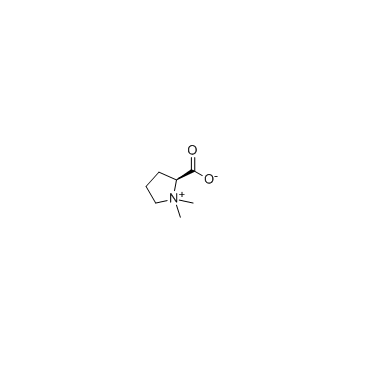Stachydrine |
| Catalog No.GC37686 |
Stachydrine is a major constituent of Chinese herb leonurus heterophyllus sweet used to promote blood circulation and dispel blood stasis.
Products are for research use only. Not for human use. We do not sell to patients.

Cas No.: 471-87-4
Sample solution is provided at 25 µL, 10mM.
Stachydrine is a major constituent of Chinese herb leonurus heterophyllus sweet used to promote blood circulation and dispel blood stasis. Stachydrine can inhibit the NF-κB signal pathway. p65 Human Endogenous Metabolite
Stachydrine can inhibit the NF-κB signal pathway, and this may be related to the mechanism of anti-hypertrophic. Intervention of stachydrine significantly suppresses the level of p-IκB protein in the cytosol and NF-κB protein in the nucleus [1]. Tissue factor mRNA is decreased in stachydrine-treated human umbilical vein endothelial cells. Stachydrine attenuates the decline of human umbilical vein endothelial cells viability and the increase of LDH activity induced by anoxia-reoxygenation[2]. A dose dependent decrease in expression of mRNA, and protein levels are observed in stachydrine-treated human prostate cancer cells (PC-3 and LNcaP)[3].
Stachydrine attenuates norepinephrine-induced cardiomyocyte hypertrophy and has potential protective effects against β-adrenergic receptor induced Ca2+ mishandling[4]. Stachydrine treatment reduces the expressions of PERK, CHOP, and caspase-3 in the endoplasmic reticulum stress-related apoptosis pathway[5].
[1]. Guo W, et al. Effect of Leonurus stachydrine on myocardial cell hypertrophy. Zhong Yao Cai. 2012 Jun;35(6):940-3. [2]. Yin J, et al. Stachydrine, a major constituent of the Chinese herb leonurus heterophyllus sweet, ameliorates human umbilical vein endothelial cells injury induced by anoxia-reoxygenation. Am J Chin Med. 2010;38(1):157-71. [3]. Rathee P, et al. In vitro anticancer activity of stachydrine isolated from Capparis decidua on prostate cancer cell lines. Nat Prod Res. 2012;26(18):1737-40. [4]. Zhang C, et al. Effects of stachydrine on norepinephrine-induced neonatal rat cardiac myocytes hypertrophy and intracellular calcium transients. BMC Complement Altern Med. 2014 Dec 8;14:474. [5]. Zhang C, et al. Effect of stachydrine on endoplasmic reticulum stress-induced apoptosis in rat kidney after unilateral ureteral obstruction. J Asian Nat Prod Res. 2013;15(4):373-81.
Average Rating: 5 (Based on Reviews and 28 reference(s) in Google Scholar.)
GLPBIO products are for RESEARCH USE ONLY. Please make sure your review or question is research based.
Required fields are marked with *




















